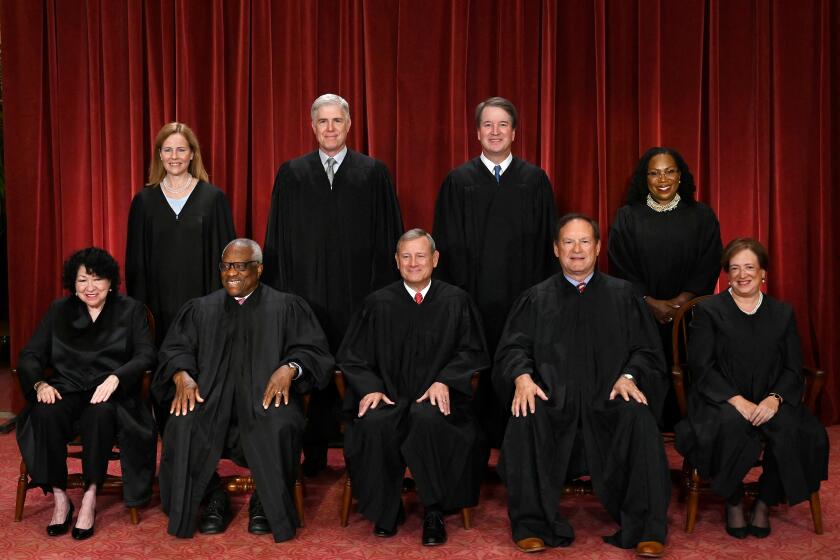2010: the Year of the Conservative Woman?
- Share via
In 1992, when the number of women elected to the U.S. Senate soared from two to six, excited pundits dubbed that four-person breakthrough “The Year of the Woman.” But it was a one-sided wave. Five of the six female senators in the 100-member Senate were liberal, pro-choice Democrats. Conservative women had long been active in Republican politics, of course, but rarely as officeholders. In those days, conservatism and feminism didn’t mix, at least not easily.
This season’s primary elections suggest that 2010 may become the Year of the Conservative Woman. The GOP’s membership in Congress is still mostly male (as is the Democrats’, of course, only a little less so). But a new generation of conservative women is running for office and winning Republican nominations, from California on Tuesday ( Meg Whitman, Carly Fiorina) to Connecticut last month (Senate candidate Linda McMahon).
GOP primary voters, a deeply conservative bunch, don’t appear to have much of a problem with strong women in public life anymore. Not only that: The GOP is consciously trying to turn gender into a selling point. This isn’t just the march of equality; it’s a strategy. Republican strategists say female candidates should run well this year, when voters are dissatisfied with incumbents of both parties, because women are, by definition, outsiders; they’re not members of the “old-boys club.”
Nikki Haley, the likely GOP candidate for governor in South Carolina, highlighted that fact explicitly, telling voters she wasn’t part of the state capital’s “frat party.” Most candidates don’t say it so explicitly; they don’t have to.
“Men are always perceived as being in a back room making deals, and women are perceived as being shut out of the back room,” says Linda DiVall, a pollster who has worked with the Republican National Committee.
In a report she gave Republican leaders last year, DiVall urged them to step up their efforts to recruit women. Conservative female candidates, she said, could appeal to swing voters more successfully than conservative men.
“Too often the Republican Party is seen as old, rigid, stern and out of touch,” DiVall said in her report. “Recruitment of female candidates, especially from outside government, will help greatly in changing perceptions of the Republican brand.”
For example, she said, when voters are asked which party’s candidates are more concerned about “people like you,” most normally choose the Democrats. But when the Republican candidate is a woman, that concern gap either narrows or disappears. A female candidate makes the GOP look warmer and friendlier.
The women who have been leading the GOP’s effort to recruit more female candidates have taken up DiVall’s thesis with enthusiasm.
“People feel that conservative women are more like them; that they know how to multitask, how to get the homework done in the evening, get the lunches ready for the next morning and have dinner in the oven before they go to work,” Rep. Marsha Blackburn (R-Tenn.), a member of the Republican leadership in the House, told me. “Voters are looking for people who can get results, who can help the government get better organized. Those are all inherently women’s skills.”
“A woman is seen, by and large, as being a good listener, as being trustworthy and honest,” said Rep. Cathy McMorris Rodgers (R-Wash.), the GOP’s chief recruiter for female House candidates this year. “The Republican brand adds the element of fiscal responsibility, which is a growing concern for all voters.”
Rodgers says it’s often still a tough sell to persuade conservative women, especially women with children at home, to run for office. “It takes a woman two years to decide to run, on average,” she said.
But changing social norms have made it easier, in part because of the gains made by an earlier generation of Democratic women.
Although Sarah Palin may be the most visible Republican woman, most of this year’s successful Republican women haven’t cast themselves in her mold.
Palin has made abortion and other social issues a central part of her appeal to supporters. Last month, Palin called for “an emerging conservative feminist identity” in a speech to the Susan B. Anthony List, an antiabortion fundraising group that bills itself as an answer to the liberal Emily’s List. Palin said a conservative “pro-woman sisterhood” should be telling young women: “They can give their child life in addition to pursuing [a] career.”
But most of this year’s female candidates have campaigned as fiscal, not social, conservatives. “Jobs [and] the economy are the top women’s issues this year,” Blackburn said, echoing DiVall’s polling. While most of the GOP’s female candidates hew to their party’s antiabortion tenets, that hasn’t been the focus of their appeal.
Asked whether Palin could help GOP candidates around the country, Rodgers paused and said: “She brings a lot of enthusiasm. She’s a force to be reckoned with. Whether or not she’s an asset in every state….”
Nor are the GOP’s new female standard-bearers all a product of the “tea party” movement, the conservative wave that has demanded ideological purity from Republican candidates.
Instead, they’re a diverse group that includes a relatively centrist former corporate CEO (Whitman), a former CEO who has tacked farther to the right (Fiorina), a former CEO of the World Wrestling Federation (McMahon) — all of whom have financed their own campaigns with millions of dollars — as well as a tea-party activist who wants to abolish the departments of energy and education (Sharron Angle, whom Nevada Republicans chose Tuesday to challenge Harry Reid for his Senate seat in November) and a long list of more traditional-sounding state legislators seeking seats in Congress.
They’re not all going to win. Even if they did, they wouldn’t be a majority; politics in both parties is still a male-dominated pursuit. But they have already broken one of the remaining parts of the glass ceiling — the section over there on the right.
More to Read
Get the L.A. Times Politics newsletter
Deeply reported insights into legislation, politics and policy from Sacramento, Washington and beyond. In your inbox twice per week.
You may occasionally receive promotional content from the Los Angeles Times.











